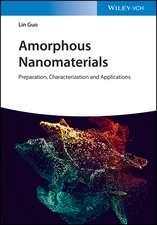Novel Electrochemical Energy Storage Devices: Materials, Architectures, and Future Trends
Autor Feng Li, Lei Wen, Hui–ming Chengen Limba Engleză Hardback – 18 mai 2021
Preț: 776.06 lei
Preț vechi: 902.39 lei
-14% Nou
Puncte Express: 1164
Preț estimativ în valută:
148.50€ • 155.44$ • 123.60£
148.50€ • 155.44$ • 123.60£
Carte disponibilă
Livrare economică 10-24 martie
Livrare express 22-28 februarie pentru 41.93 lei
Preluare comenzi: 021 569.72.76
Specificații
ISBN-13: 9783527345793
ISBN-10: 3527345795
Pagini: 336
Dimensiuni: 177 x 249 x 21 mm
Greutate: 0.73 kg
Editura: Wiley Vch
Locul publicării:Weinheim, Germany
ISBN-10: 3527345795
Pagini: 336
Dimensiuni: 177 x 249 x 21 mm
Greutate: 0.73 kg
Editura: Wiley Vch
Locul publicării:Weinheim, Germany
Cuprins
1 INTRODUCTION
1.1 Energy Conversion and Storage: A Global Challenge
1.2 Development history of electrochemical energy storage
1.3 Classification of electrochemical energy storage
1.4 LIBs and ECs: an appropriate electrochemical energy storage
1.5 Summary and Outlook
2 MATERIALS AND FABRICATION
2.2 Mechanisms and advantages of ECs
2.2.1 Categories
2.3 Roadmap of conventional materials for LIBs
2.4 Typical positive materials for LIBs
2.5 Typical negative materials for LIBs
2.6 New materials for LIBs
2.7 Materials for conventional ECs
2.8 Electrolytes and separators
2.9 Evaluation methods
2.10 Production processes for the fabrication
2.11 Perspectives
3 FLEXIBLE CELLS: THEORY AND CHARACTERIZATIONS
3.1 Limitations of the conventional cells
3.2 Mechanical process for bendable cells
3.3 Mechanics of stretchable cells
3.4 Static electrochemical performance of flexible cells
3.5 Dynamic performance of flexible cells
3.6 Summary and perspectives
4 Flexible Cells: Materials and Fabrication Technologies
4.1 Construction principles of flexible cells
4.2 Substrate materials for flexible cells
4.3 Active materials for flexible cells
4.3.1 CNTs
4.4 Electrolytes for flexible LIBs
4.5 Electrolytes for flexible ECs
4.6 Nonconductive substrates based flexible cells
4.7 CNT and graphene based flexible cells
4.8 Construction of stretchable cells by novel architectures
4.9 Conclusion and Perspectives
5 ARCHITECTURES DESIGN FOR CELLs WITH HIGH ENERGY DENSITY
5.1 Strategies for high energy density cells
5.2 Gravimetric and volumetric energy density of electrodes
5.3 Classification of thick electrodes: bulk and foam electrodes
5.4 Design and fabrication of bulk electrodes
5.5 Characterization and numerical simulation of tortuosity
5.6 Fabrication methods for bulk electrodes
5.7 Thick electrodes with random pore structure
5.8 Thick electrodes with directional pore distribution
5.9 Carbon based foam electrodes with high gravimetric energy density
5.10 Carbon based thick electrodes
5.11 Thick electrodes based on the conductive polymer gels
5.12 Summary and Perspectives
6 MINIATURIZED CELLS
6.1 Introduction
6.2 Evaluation methods for the miniaturized cells
6.3 Architectures of various miniaturized cells
6.4 Materials for the miniaturized cells
6.5 Fabrication technologies for miniaturized cells
6.6 Fabrication technologies for 2D interdigitated cells
6.7 Printing technologies for 2D interdigitated cells
6.8 Electrochemical deposition method for 2D interdigitated cells
6.9 Laser scribing for 2D interdigitated cells
6.10 In-situ electrode conversion for 2D interdigitated cells
6.11 Fabrication technologies for 3D in-plane miniaturized cells
6.12 Fabrication of miniaturized cells with 3D stacked configuration
6.13 Integrated systems
6.14 Summary and perspectives
7 SMART CELLS
7.1 Definition of smart materials and cells
7.2 Type of smart materials
7.3 Construction of smart cells
7.4 Application of shape-memory materials in LIBs and ECs
7.5 Self-heating and self-monitoring designs
7.6 Integrated electrochromic architectures for energy storage
7.7 Summary and perspectives

















